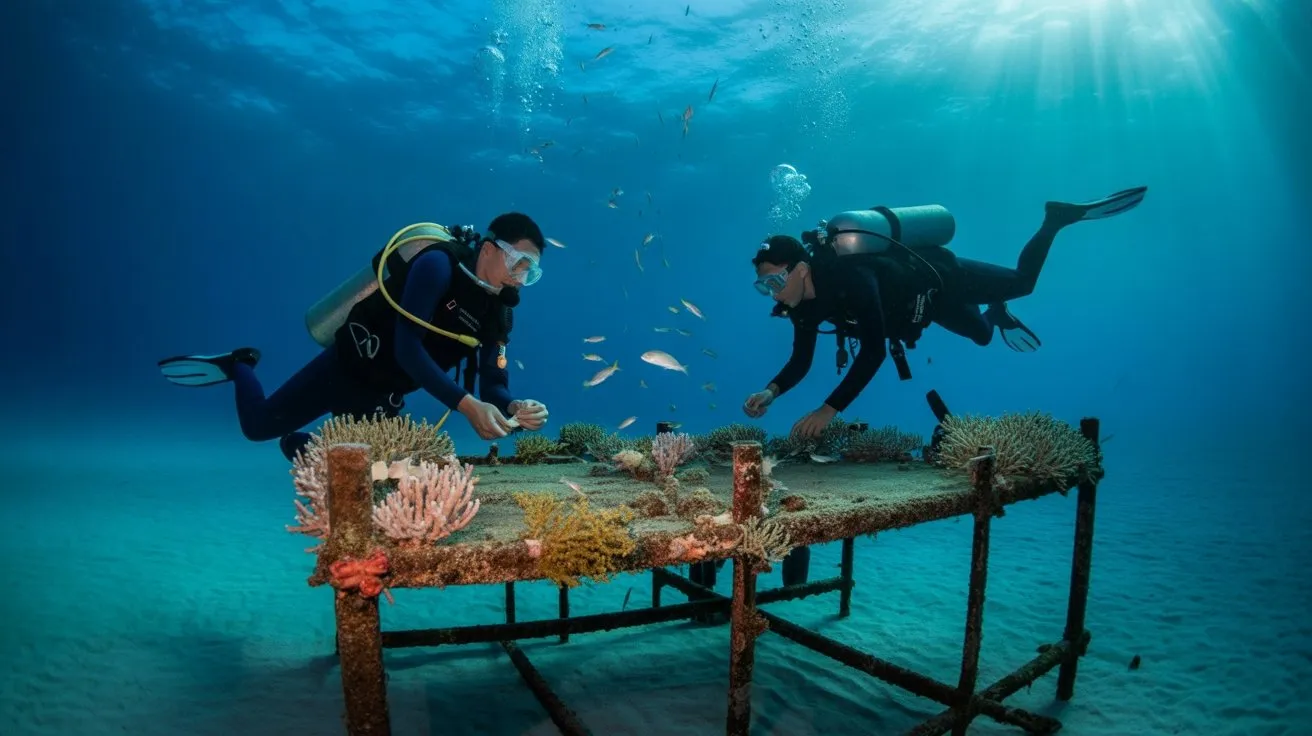When you observe a coral reef, you’re witnessing one of Earth’s most intricate trophic networks in action. Each organism occupies a specific niche within this marine ecosystem, from primary producers synthesizing energy through photosynthesis to apex predators regulating population dynamics at multiple trophic levels. You’ll discover that understanding these feeding relationships reveals the delicate balance maintaining reef biodiversity—and explains why disrupting even one link can trigger cascading effects throughout the entire system.
Primary Producers: The Foundation of Reef Energy
Photosynthesis drives the entire coral reef ecosystem through its primary producers, which convert sunlight into chemical energy that fuels complex food webs.
You’ll find zooxanthellae, symbiotic dinoflagellates living within coral polyp tissues, producing up to 90% of their host’s energy requirements through photosynthetic processes.
Macroalgae and turf algae colonize available reef surfaces, while seagrass beds in adjacent sandy areas contribute significant biomass.
Phytoplankton in surrounding waters provide additional primary production, particularly in nutrient-rich upwelling zones.
These producers establish the ecosystem’s energy foundation, with their photosynthetic efficiency determining carrying capacity for herbivorous fish, invertebrates, and subsequently higher trophic levels.
You’re observing an intricate network where light energy transforms into the chemical bonds that sustain reef biodiversity. Additionally, the presence of coral-algae symbiosis enhances the productivity and resilience of the entire reef ecosystem.
Microscopic Grazers: Zooplankton and Phytoplankton Dynamics
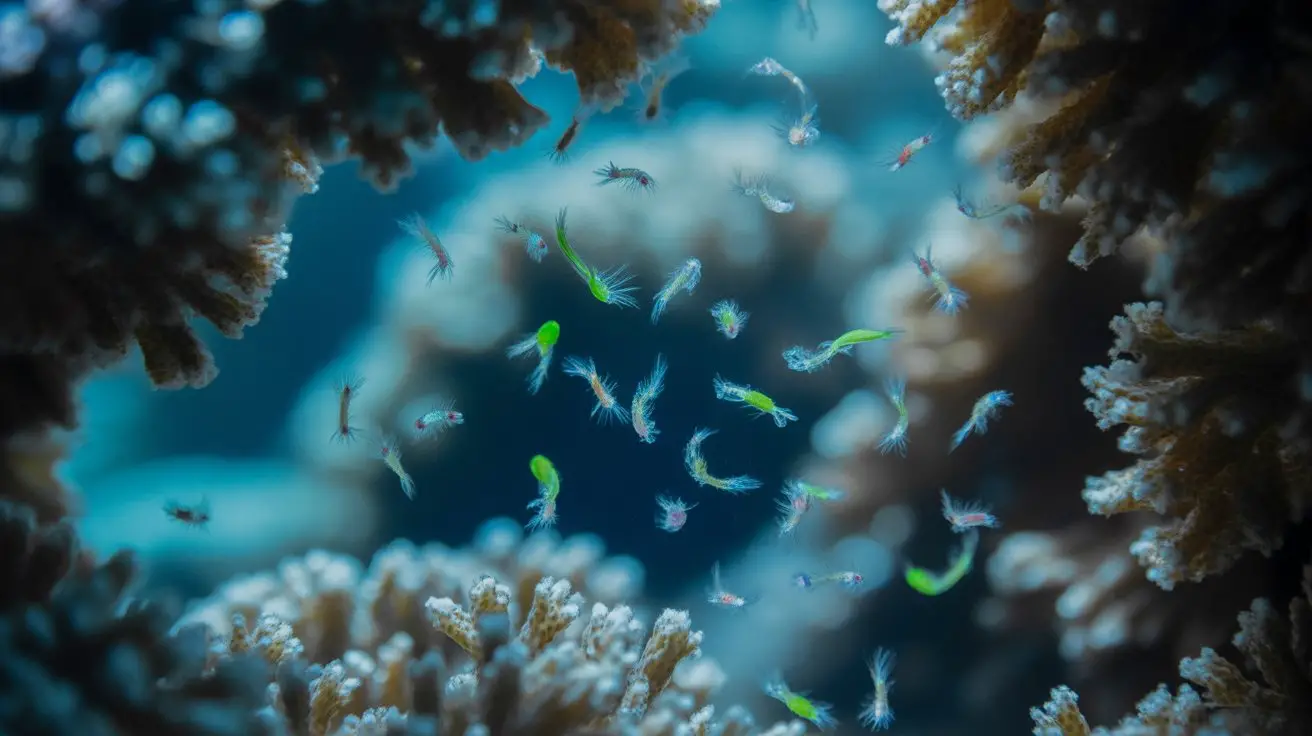
While phytoplankton form the microscopic foundation of reef productivity, zooplankton create the critical link between primary producers and larger reef organisms through their grazing activities and subsequent predation.
You’ll observe copepods, larvaceans, and other microzooplankton actively filtering phytoplankton from the water column, converting plant biomass into animal protein.
These microscopic grazers exhibit diel vertical migration patterns, rising to surface waters at night to feed and descending during daylight hours to avoid visual predators. Their grazing pressure considerably influences phytoplankton population dynamics and species composition.
You’ll notice that zooplankton reproduction cycles often synchronize with phytoplankton blooms, maximizing energy transfer efficiency.
This microscopic predator-prey relationship establishes the foundational energy pathway that supports all higher trophic levels within the coral reef ecosystem. Additionally, the health of coral reefs is closely linked to marine fish diversity, which relies on a balanced food web to thrive.
Herbivorous Fish: Nature’s Reef Landscapers

Parrotfish, surgeonfish, and tangs function as the reef’s primary algae control specialists, maintaining the delicate balance between coral growth and algal overgrowth through their constant grazing activities.
You’ll observe parrotfish using their beak-like mouths to scrape algae and polyps from coral surfaces, inadvertently consuming calcium carbonate and producing sand through their digestive processes.
Surgeonfish and tangs employ specialized pharyngeal teeth to process tough algal filaments, while their streamlined bodies enable efficient foraging across extensive reef territories.
These herbivores prevent competitive macroalgae from smothering coral polyps, ensuring adequate light penetration for zooxanthellae photosynthesis.
Their selective feeding creates spatial heterogeneity, establishing algal-free zones where coral larvae can successfully settle and develop into mature colonies, ultimately shaping reef architecture. Additionally, healthy predator populations promote greater biodiversity and contribute to the overall health of coral reef ecosystems.
Filter Feeders: Living Water Purification Systems
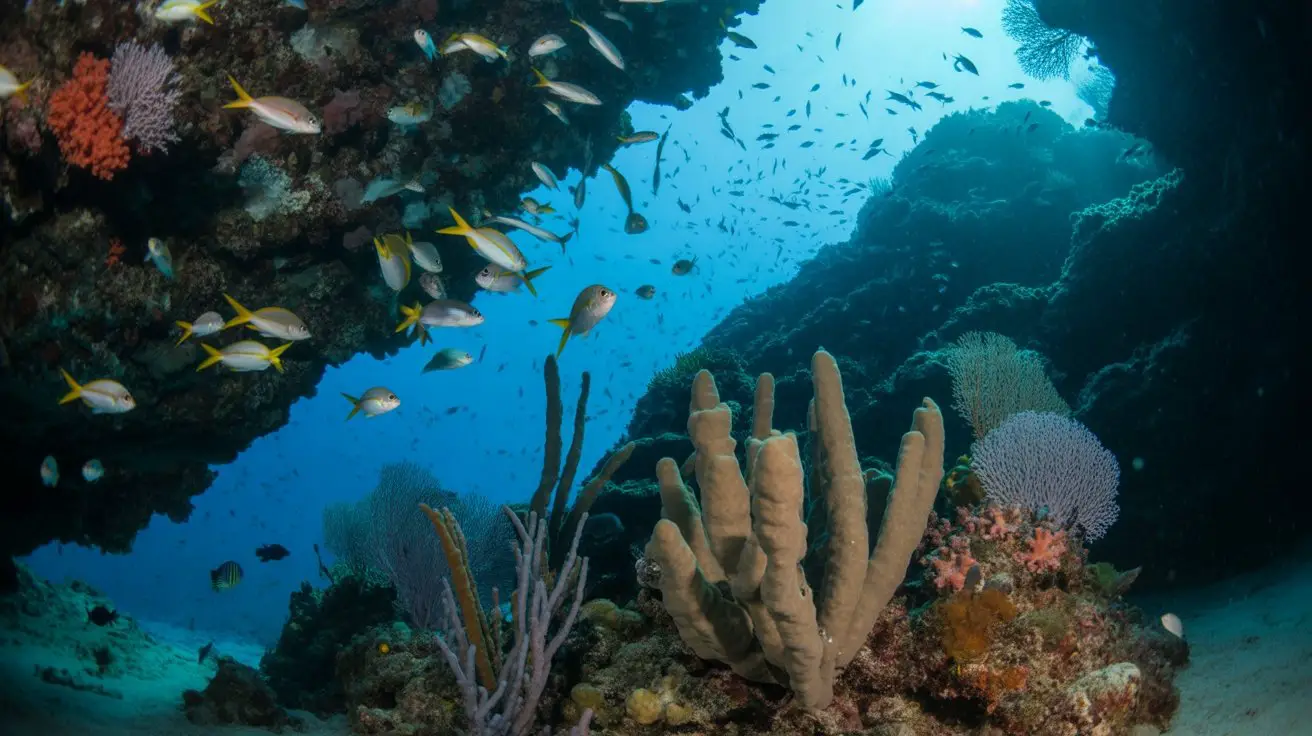
Millions of microscopic organisms flow through coral reef waters every second, creating an abundant food source that sponges, bivalves, and tunicates exploit through sophisticated filtration mechanisms.
You’ll observe these organisms actively pumping water through specialized chambers, extracting phytoplankton, bacteria, and dissolved organic matter with remarkable efficiency.
Sponges process hundreds of liters daily through their porous bodies, while giant clams filter-feed using modified gills that capture particles as small as 0.2 micrometers.
Sea squirts employ ciliated pharyngeal slits to trap suspended nutrients.
These filter feeders don’t just consume microscopic prey—they’re removing excess nutrients that could trigger algal blooms.
You’re witnessing biological water treatment systems that maintain reef water clarity and prevent eutrophication, making them essential ecosystem engineers alongside reef-building corals. Additionally, these organisms play a crucial role in supporting biodiversity in marine ecosystems, which is vital for the overall health of coral reefs.
Small Carnivores: Opportunistic Hunters of the Reef
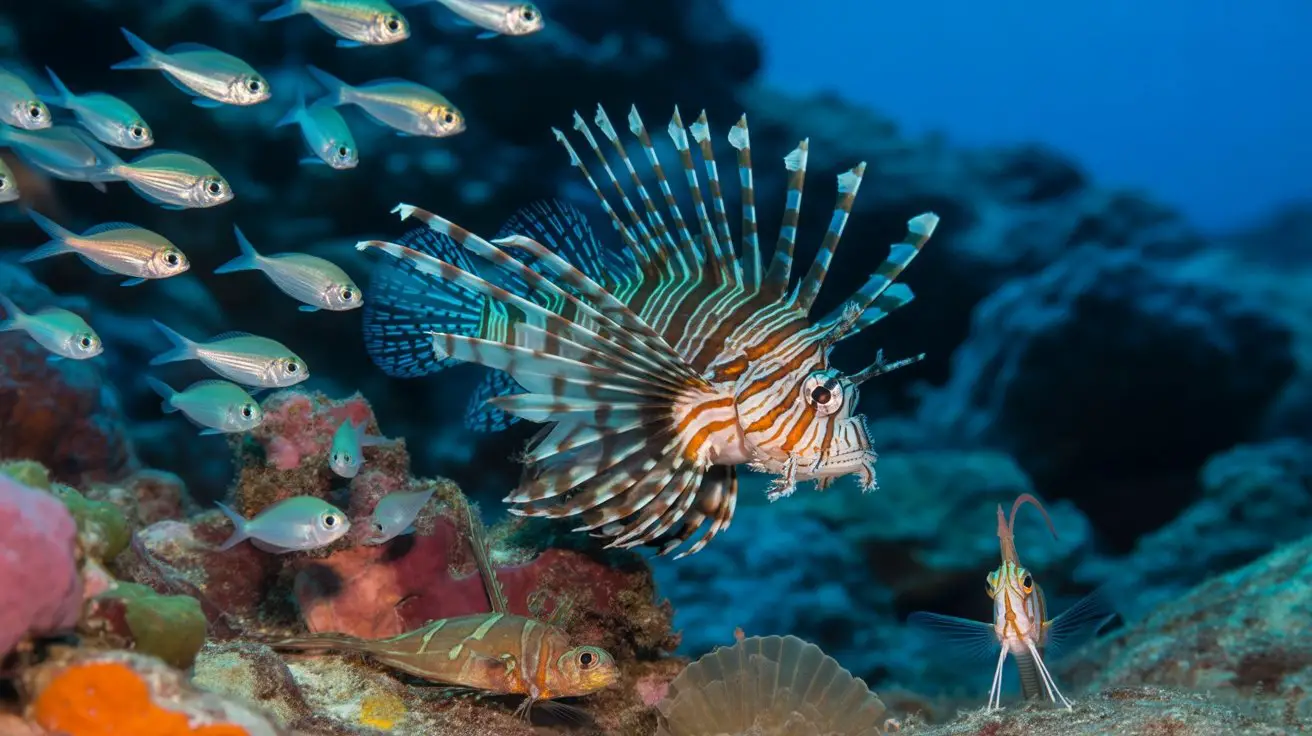
Beyond the patient filter feeders that cleanse reef waters, you’ll encounter a dynamic assemblage of small carnivores actively pursuing mobile prey throughout the coral matrix.
These opportunistic hunters include wrasses, which extract invertebrates from crevices using specialized pharyngeal jaws, and butterflyfish that target coral polyps with elongated rostra.
Hawkfish perch motionlessly on coral heads, ambushing small crustaceans and polychaete worms with rapid strikes.
Dottybacks dart between coral branches, capturing juvenile fish and mysid shrimp.
You’ll observe triggerfish employing powerful jaws to crush sea urchins and mollusks, while cardinalfish form feeding aggregations during crepuscular periods to exploit emerging zooplankton.
These predators maintain population control throughout lower trophic levels, preventing any single prey species from overwhelming the ecosystem’s delicate equilibrium.
Mid-Level Predators: Balancing the Marine Ecosystem
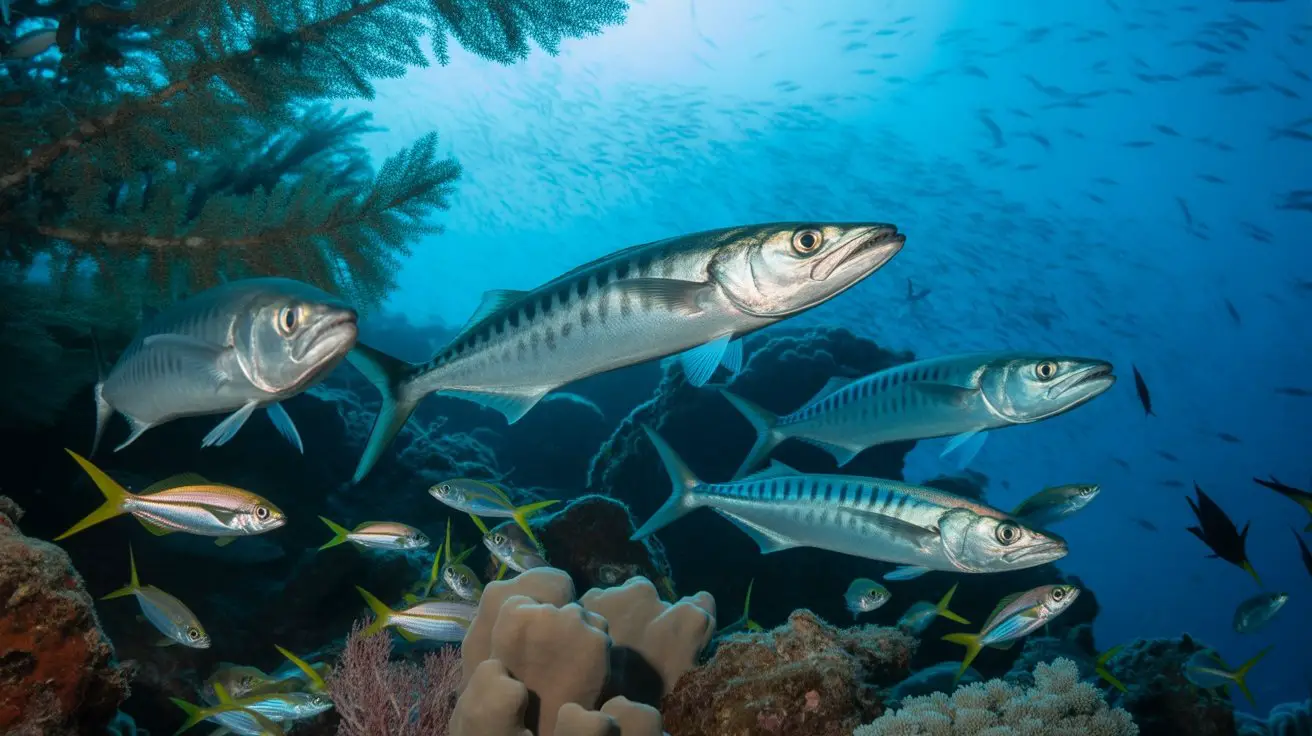
As energy flows upward through reef trophic levels, you’ll encounter larger predators that occupy crucial intermediate positions within this complex food web.
These mid-level carnivores include groupers, snappers, moray eels, and reef sharks that actively regulate prey populations below them.
You’ll observe groupers employing ambush tactics from coral crevices, targeting smaller fish and crustaceans. Snappers form hunting aggregations during twilight hours, efficiently capturing juvenile fish in coordinated strikes.
Moray eels navigate tight reef spaces, preying on octopi, crabs, and fish that smaller predators can’t access. Caribbean reef sharks patrol open water zones, controlling populations of medium-sized fish.
These predators maintain ecosystem stability by preventing any single prey species from dominating reef communities. Their role is vital for maintaining balanced populations and promoting natural behaviors, which sustains the overall health of reef ecosystems.
Apex Predators: Sharks and the Top of the Food Chain

At coral reef ecosystems’ apex, large sharks command the highest trophic level and exert profound influence over marine community structure through top-down predation pressure.
You’ll observe species like Caribbean reef sharks, blacktip sharks, and nurse sharks patrolling territorial boundaries while maintaining population equilibrium among mid-level predators. Their selective predation removes weak, diseased, or genetically inferior individuals, strengthening prey species’ overall fitness.
You’ll notice these apex predators don’t maintain permanent residence but rather follow migratory patterns, creating temporal variation in predation intensity. Their presence triggers behavioral cascades—smaller predators alter hunting patterns, herbivorous fish modify grazing locations, and schooling species adjust aggregation behaviors.
This trophic cascade effect maintains coral reef biodiversity by preventing any single species from monopolizing resources or habitat space. Additionally, marine mammals, such as seals and sea lions, contribute to the overall health of coral reef ecosystems by serving as indicators of environmental changes.
Decomposers and Scavengers: Recycling Ocean Nutrients
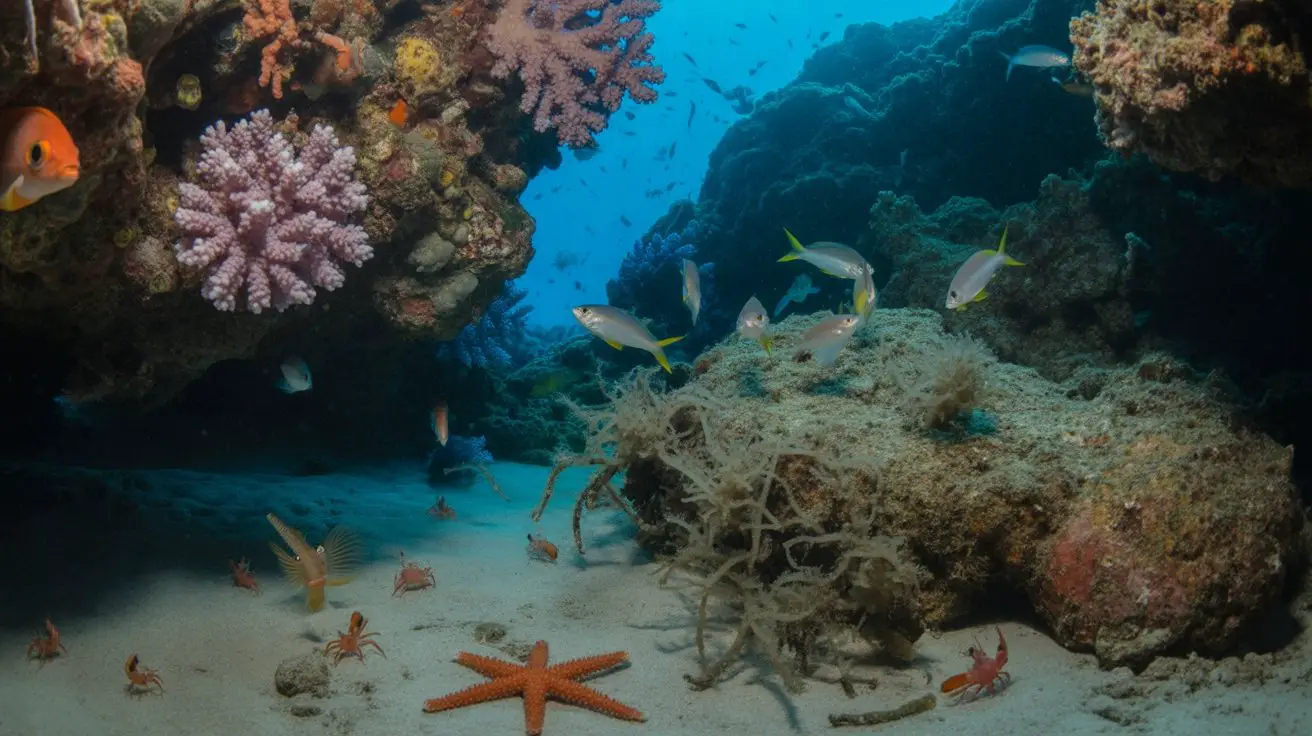
While apex predators capture attention at coral reefs’ summit, decomposers and scavengers operate as the ecosystem’s vital recycling machinery, breaking down organic matter and returning significant nutrients to the water column.
You’ll observe bacteria functioning as primary decomposers, converting dead organisms into dissolved organic compounds through enzymatic breakdown.
Marine worms, including polychaetes and oligochaetes, process detritus within sediment layers, accelerating decomposition rates.
Crustacean scavengers like hermit crabs and amphipods consume carrion, fragmenting larger organic materials into smaller particles.
These organisms facilitate nutrient cycling by releasing nitrogen, phosphorus, and carbon compounds back into solution.
You’ll notice this process maintains reef productivity by making essential elements available for primary producers.
Without decomposers’ metabolic activities, organic matter would accumulate, disrupting the reef’s delicate biogeochemical balance and reducing overall ecosystem efficiency.
Symbiotic Relationships: Mutual Benefits in Reef Communities
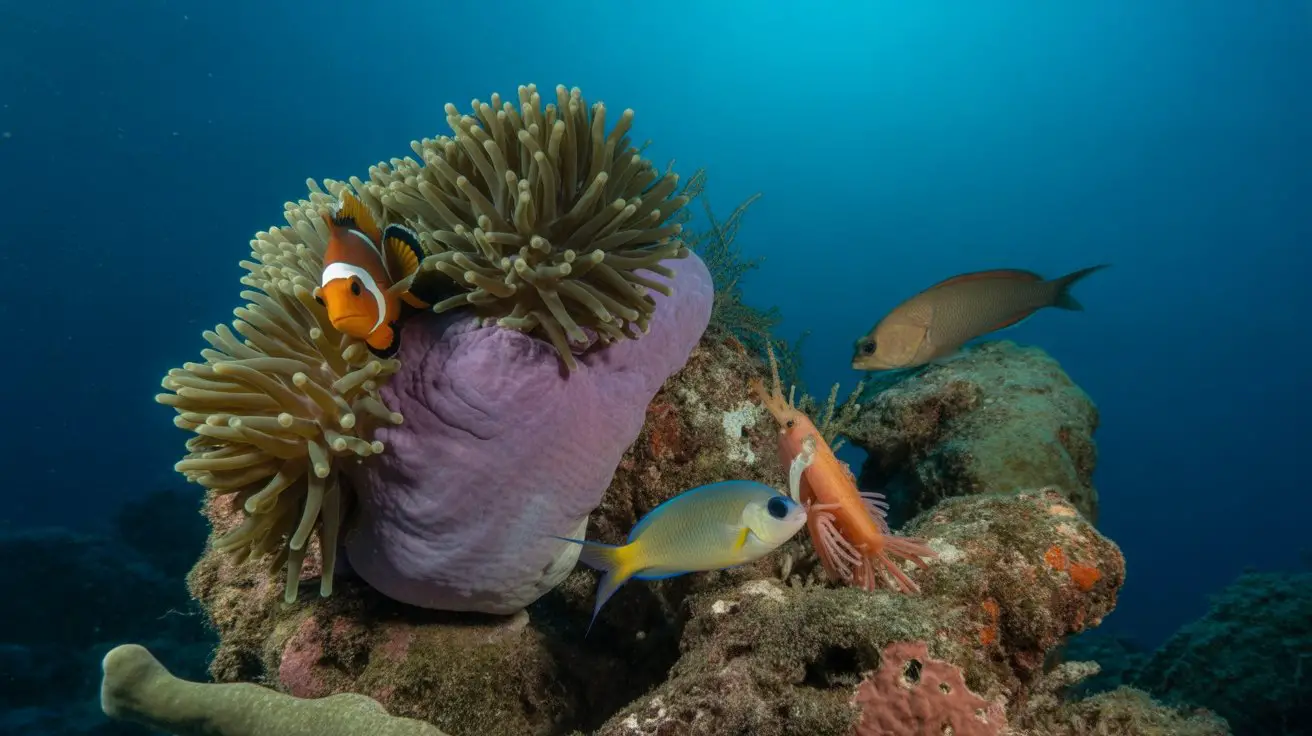
Beyond the essential work of decomposition, coral reefs showcase nature’s most intricate partnerships through symbiotic relationships that define ecosystem structure and function.
You’ll observe zooxanthellae algae living within coral polyp tissues, providing up to 90% of their host’s energy through photosynthesis while receiving shelter and nutrients.
Cleaner fish establish mutualistic stations where they remove parasites from larger species, gaining food while improving their clients’ health.
You’ll notice clownfish sheltering among anemone tentacles, protected by specialized mucus coatings while providing nutrients through waste products.
These partnerships create interdependent networks that stabilize reef communities, enhance biodiversity, and increase overall ecosystem resilience against environmental stressors through coordinated survival strategies. Additionally, these relationships contribute to the overall biodiversity of coral reefs, crucial for maintaining the health of marine life.
Conclusion
You’ve witnessed how each trophic level maintains the reef’s delicate equilibrium through precise ecological interactions. From zooxanthellae’s photosynthetic output to apex predators’ regulatory pressure, you’re observing a system where energy transfer efficiency determines community structure. When you remove one component—whether it’s herbivorous grazers or filter-feeding organisms—you’ll trigger cascading effects throughout the entire food web. This interconnected network demonstrates that you can’t understand reef ecology without recognizing each species’ functional role.





